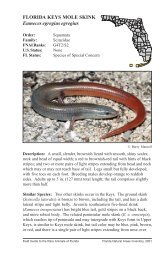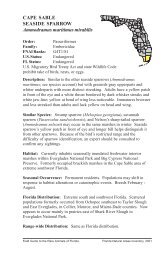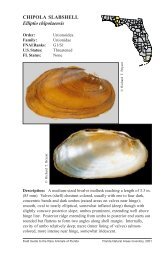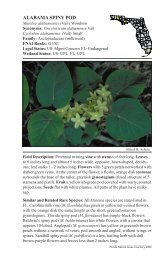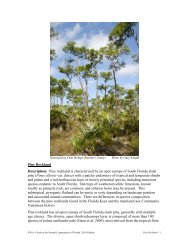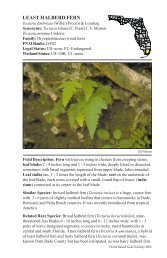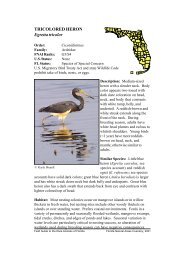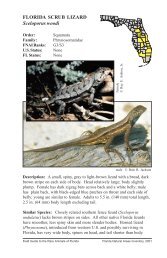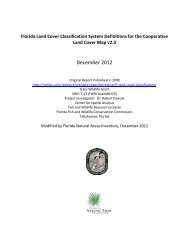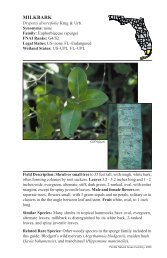SUWANNEE BASS Micropterus notius - Florida Natural Areas ...
SUWANNEE BASS Micropterus notius - Florida Natural Areas ...
SUWANNEE BASS Micropterus notius - Florida Natural Areas ...
Create successful ePaper yourself
Turn your PDF publications into a flip-book with our unique Google optimized e-Paper software.
<strong>SUWANNEE</strong> <strong>BASS</strong><br />
<strong>Micropterus</strong> <strong>notius</strong><br />
Order: Perciformes<br />
Family: Centrarchidae<br />
FNAI Ranks: G3/S3<br />
U.S. Status: None<br />
FL Status: Species of Special Concern<br />
Description: Medium-sized bass, up to 16 in. (406 mm), similar in<br />
coloration to the more common largemouth bass (<strong>Micropterus</strong> salmoides);<br />
upper jaw extends to a point below the eye; breeding males develop bright<br />
turquoise on the cheek, breast and belly.<br />
Similar Species: Upper jaw of largemouth bass extends well past eye.<br />
Suwannee bass usually has teeth on the tongue, while largemouth bass<br />
usually does not; these teeth can be detected by examining with thumb.<br />
Habitat: Prefers fast-moving shoal areas with a limestone bottom which is<br />
often covered by sand. Suwannee bass generally prefers neutral or basic<br />
waters, such as those provided by springs emanating from the limestone<br />
aquifer. Found occasionally in the lower, tidally influenced portions of the<br />
Suwannee River, but not found in the upper portions where the acidic<br />
character of the Okefenokee Swamp dominates stream composition.<br />
Seasonal Occurrence: Present in all seasons.<br />
© Joe Tomelleri<br />
<strong>Florida</strong> Distribution: Ochlockonee, Suwannee/Santa Fe, St. Marks, and<br />
Wacissa rivers.<br />
Field Guide to the Rare Animals of <strong>Florida</strong> <strong>Florida</strong> <strong>Natural</strong> <strong>Areas</strong> Inventory, 2001
<strong>SUWANNEE</strong> <strong>BASS</strong> <strong>Micropterus</strong> <strong>notius</strong><br />
Range-wide Distribution: Ochlockonee and Suwannee River basins in<br />
Georgia and <strong>Florida</strong> and the above-mentioned <strong>Florida</strong> drainages.<br />
Conservation Status: Most of the inhabited rivers in <strong>Florida</strong> have some<br />
impairment of water quality or are expected to experience a downward<br />
trend. However, populations appear to be stable in the Suwannee/Santa Fe<br />
system; less is known of their status in the Ochlockonee River. Populations<br />
in the St. Marks and Wacissa rivers are thought to have been introduced.<br />
Protection and Management: Monitor water quality and ameliorate<br />
sources of degradation. The current 12-in. (305 mm) size limit on bass, in<br />
the Suwannee River and westward, should protect Suwannee bass from<br />
over-exploitation by anglers.<br />
Selected References: Georgia DNR 1999, Gilbert (ed.) 1992, Hoehn 1998,<br />
Page and Burr 1998.<br />
Field Guide to the Rare Animals of <strong>Florida</strong> <strong>Florida</strong> <strong>Natural</strong> <strong>Areas</strong> Inventory, 2001




